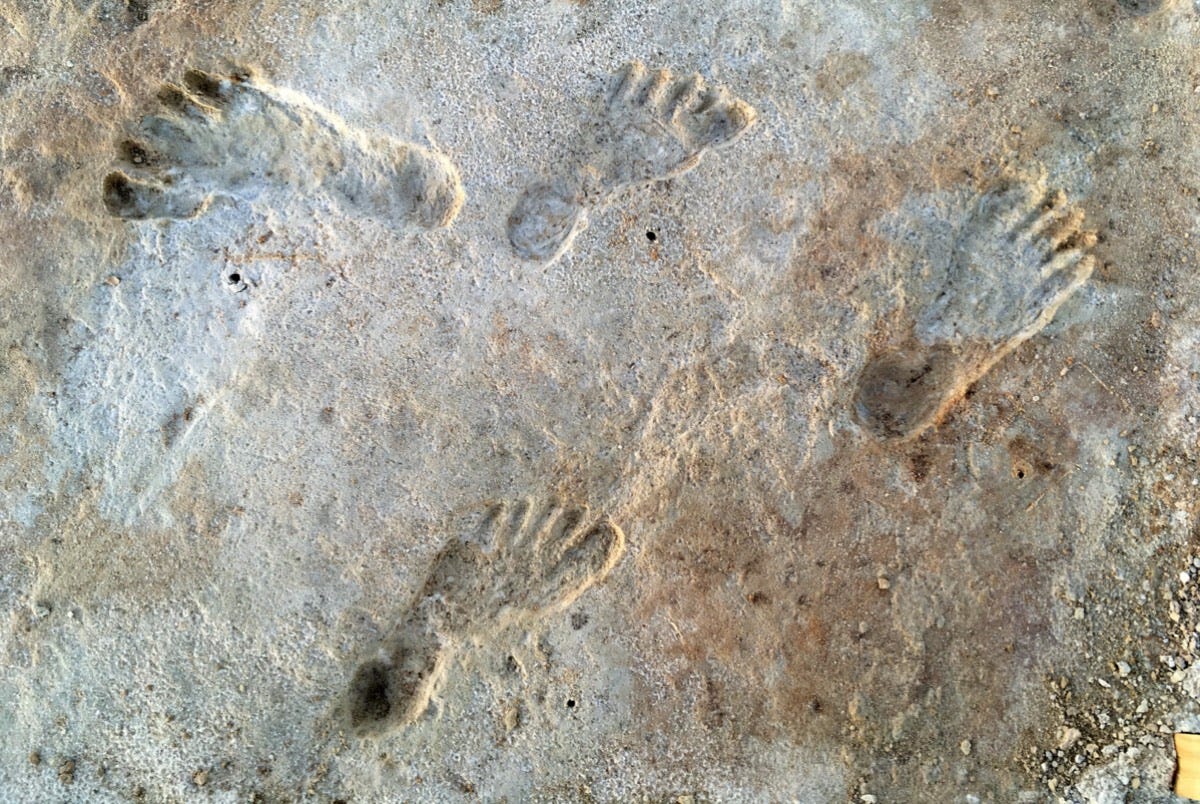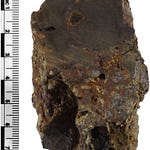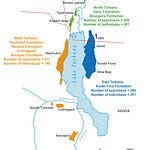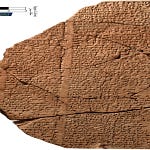In the gypsum dunes of southern New Mexico, in a place once soaked by an ancient lake, a trail of footprints has prompted a deep rethinking of when—and how—humans first arrived in the Americas. Those impressions, discovered in the now-dry sediments of White Sands National Park, are not merely the ephemeral traces of an afternoon walk but may represent the oldest direct evidence of human presence in North America.

A new study, published in Science Advances1 by Vance Holliday and colleagues, adds weight to an increasingly robust claim: that people were in what is now the American Southwest between 21,000 and 23,000 years ago, deep within the Last Glacial Maximum (LGM). This period marked the peak of the last Ice Age, when colossal ice sheets blanketed much of the northern continent. The findings challenge decades of consensus shaped by the Clovis-first model, which held that humans only entered the Americas around 13,000 years ago via an interior ice-free corridor.
"You get to the point where it's really hard to explain all this away," said Holliday, a geologist and archaeologist at the University of Arizona. "It would be serendipity in the extreme to have all these dates giving you a consistent picture that's in error."
Layers of mud and time
The White Sands footprints were first excavated in 2019, embedded in a layer of fine clay along the margins of the ancient Lake Otero. Initial radiocarbon dating of aquatic plant seeds suggested an age of 21,000 to 23,000 years. However, the findings sparked immediate debate. Critics questioned whether the seeds—Ruppia cirrhosa, a plant known to draw ancient carbon from groundwater—might have skewed the results.

To address the skepticism, the team conducted multiple follow-up studies. In 2023, they radiocarbon-dated terrestrial pollen grains and employed optically stimulated luminescence dating on surrounding quartz grains, both of which supported the initial estimates.
Now, with the publication of the 2025 study, the team has added a third line of evidence: radiocarbon dating of organic-rich lakebed muds associated with the footprints. The results, analyzed by two independent labs, converge again on an age of roughly 21,000 to 23,000 years. In total, 55 radiocarbon dates from seeds, pollen, and sediment now outline a consistent timeline for the tracks.
A lakeside world
During the LGM, White Sands wasn’t a dune field but the basin of a sprawling shallow lake known as Lake Otero. The tracks were found in a low-energy alluvial setting along its eastern margin, part of a complex mosaic of wetlands, silts, and ephemeral channels.
These weren’t fleeting imprints in sand. The people who walked across the area stepped into saturated clay that preserved their movements like wet cement. As water levels shifted, new layers of sediment sealed these ancient steps beneath gypsum and mud.
Alongside the human prints are the tracks of long-extinct megafauna: mammoths, ground sloths, ancient camels. They hint at a rich ecosystem where humans and Ice Age giants crossed paths.
The artifact conundrum
One of the remaining puzzles is the absence of stone tools or other archaeological debris typically associated with human activity. Critics argue that if humans were present, where are their tools?
Holliday and others counter that the nature of hunter-gatherer behavior makes such absence plausible. The tracks likely formed during short visits to the lake margin—perhaps for hunting, gathering, or simply traveling. In such brief episodes, people may have left little behind.
"These people live by their artifacts, and they were far away from where they could get replacement material," said Holliday. "They're not just randomly dropping tools. It's not logical to expect a debris field."
Rethinking first arrivals
The Clovis-first model has been under siege for years. Sites in Florida, Idaho, and Texas have produced earlier dates, but often without the clarity or contextual detail needed to shift the broader consensus. The White Sands footprints differ in one critical way: they are human traces, not just artifacts.
They record not just presence, but motion. Children and adults walking together. People turning, pausing, stepping in the prints of mammoths. It's a record of life unfolding in real time.
The 2025 study doesn’t settle every question. But it makes the dating harder to dispute. And it suggests that the first Americans may have arrived thousands of years before the glaciers released their grip on the northern continent. If that’s true, they didn’t come through an ice-free corridor. They likely hugged the Pacific coast, perhaps using boats, in a migration path that still remains archaeologically elusive.
The footprints at White Sands offer a quiet but persistent argument. Long before Clovis points pierced mammoth hide, before spearheads littered the Plains, someone walked across the edge of a lake in what is now southern New Mexico. They left behind only footprints, but their presence is no longer easy to dismiss.
Suggested Related Research:
Bennett, M. R., et al. (2021). "Evidence of humans in North America during the Last Glacial Maximum." Science, 373(6562), 1528-1531. https://doi.org/10.1126/science.abg7586
Pigati, J. S., et al. (2023). "Independent age estimates resolve the controversy of ancient human footprints in White Sands National Park." Science, 382(6669), 73-75. https://doi.org/10.1126/science.adg1933
Davis, L. G., et al. (2019). "Late Upper Paleolithic occupation at Cooper's Ferry, Idaho, USA, ∼16,000 years ago." Science, 365(6456), 891-897. https://doi.org/10.1126/science.aax9830
Halligan, J. J., et al. (2016). "Pre-Clovis occupation 14,550 years ago at the Page-Ladson site, Florida, and the peopling of the Americas." Science Advances, 2(5), e1600375. https://doi.org/10.1126/sciadv.1600375
Oviatt, C. G., et al. (2023). "A critical assessment of claims that human footprints in the Lake Otero Basin, New Mexico date to the Last Glacial Maximum." Quaternary Research, 111, 138–147. https://doi.org/10.1017/qua.2022.65
Holliday, V. T., Windingstad, J. D., Bright, J., Phillips, B. G., Butler, J. B., Breslawski, R., & Bowman, J. E. (2025). Paleolake geochronology supports Last Glacial Maximum (LGM) age for human tracks at White Sands, New Mexico. Science Advances, 11(25). https://doi.org/10.1126/sciadv.adv4951










